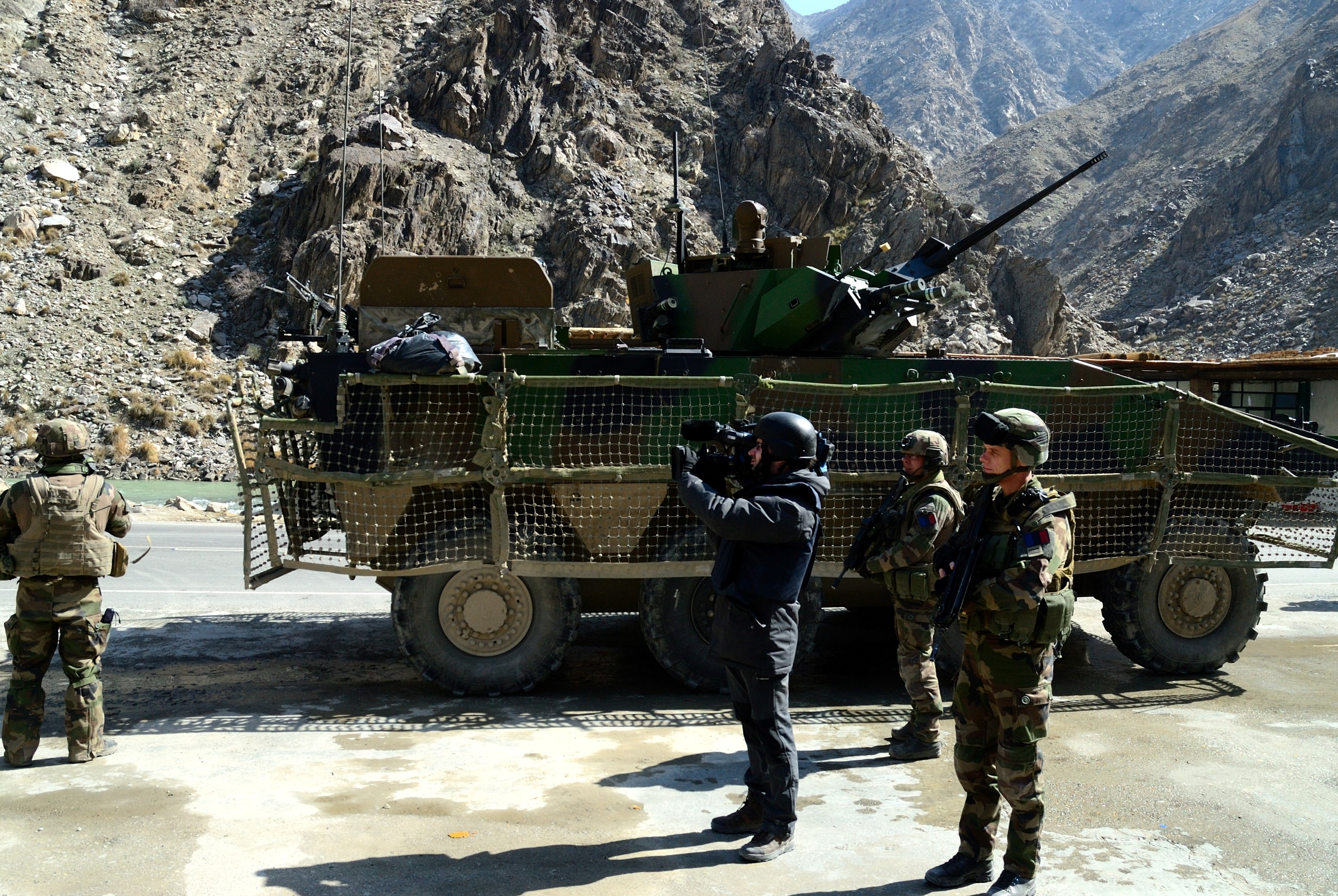Journalism Covers a War Like No Other: It's Not Just in Ukraine

A few days before Russia annexed Crimea in March 2014, Vladislav Surkov, then Vladimir Putin's chief image-maker, ideologue and eminence grise, published a short story. Among other things, Surkov masterminded and helped manage the disinformation campaign against Ukraine. Surkov left the Kremlin in 2021, but it would be a mistake to ignore his futuristic tale about a fifth world war. With Russian forces poised to attack Ukraine, it's an outline of Putin's strategy. Unfortunately, the news media can't seem to figure out how to cover the story, much less explain its play by play.
Surkov's fiction describes the war of the future. "It was the first non-linear war," he wrote. "In the primitive wars of the 19th and 20th centuries it was common for just two sides to fight … Now four coalitions collided. Not two against two, or three against one. No. All against all. And what coalitions! Not like the ones you had before ... It was rare for whole countries to enter. A few provinces would join one side, a few others a different one. One town or generation or gender would join yet another. Then they could switch sides, sometimes mid-battle. Their aims were quite different … Most understood the war to be part of a process. Not necessarily its most important part."
The story deserves attention as more than high concept. Surkov turned his ideas into real-world weapons at home and abroad. From helping suffocate Russian democracy to distorting the reality surrounding Moscow's serial aggressions in its near abroad, his accomplishments at Putin's elbow speak for themselves. So does his short story's scarcely veiled description of the future of information at war. Just ask Russia's generals. They paid attention and aren't hiding their game. Lt. General Andrei Kartapolov put it this way in 2015. "A classical war…consisted usually of 80 percent violence and 20 percent propaganda. New type wars consist of 80-90 percent propaganda and 10-20 percent violence." Stay tuned for coming events in Ukraine.
For Americans who want to understand what Putin is up to, the message from Russia's media manipulators and military brass couldn't be clearer. When it comes to the role of information in the 21st century's wars, forget about old-fashioned differences between war and peace, conventional and clandestine conflict, the home front and the battle front and whether fighting is near or far away. The distinctions are as quaint as castle moats, cavalry charges and close order drills. A new book by Phil Seib, a professor of journalism and public diplomacy at the University of Southern California and an expert on the media and war, explains why the world of information has fundamentally changed the business of war, and much more.
"Information at war has always been a weapon in itself … that can influence the outcome of conflicts," Seib writes in Information at War: Journalism, Disinformation and Modern Warfare. Reflecting both his scholarship and journalist's credentials, the book provides exceptionally timely analysis and case studies as well as a solidly grounded history. Seib traces the twinned evolution in technology and media, describing the growing power of information in shaping the conflicts of the 20th and 21st centuries. Past is prologue and his examples are vivid. Begin with Edward R. Murrow's radio broadcasts in 1940 as German bombs rained on London; cut to television news turning Vietnam into the 1960s' living room war; and take a tight shot of U.S. soldiers blogging on their way to Baghdad in 2003. The cases capture and help explain a century of turning points in the media and information's wartime role.
Seib is not just writing about the news. "A basic premise," he explains, "is that if government wants to wage war, it must control -- or at least influence -- the media eco-system." Seib makes the point by portraying how things have gone. From feeding cable news vacuous content to meet its insatiable demand for imagery and embedding journalists who cheer led rather than covered the first Iraq war, to failing to corral citizen journalists and crowd-sourced outlets that reported on cover-ups, torture and civilian casualties in the years that followed, the implication is obvious. Advancing technology in an increasingly connected world is steadily raising the bar for any government effort to manage the media in all its hydra-headed forms.
Information at War is refreshingly free of abstruse academic theory, social science jargon and media speak. Seib writes clearly about complex subjects and lets facts do the talking. His picture of the changing information landscape also portrays the growing challenges for governments as information's potential as a weapon becomes even more pervasive. For example, compare the United States in 1921 when its 30 radio stations broadcast to the 60,000 American households that had radios, and 2020 when 60 percent of the world's 7.8 billion people use the Web. The impact of communications technology and information on political leaders as well as generals is impossible to miss.
Seib offers neither reassurances nor dire warnings about the future. His conclusions make clear the complexities in forecasting are simply too great. Malignant social media, the demise of professional news organizations as gatekeepers, and the public's civic as well as media illiteracy all cloud the crystal ball. As vulnerabilities, they're also daunting to fix. Indeed, Seib's description of the current national effort to confront information at war is understated. "In most countries," he writes, "defending against information attacks has not yet been accorded an appropriate level of coherent doctrine." Considering the attacks Moscow, Beijing, Tehran and others are mounting here, it's fair to say his judgment is generous, to say the least.
Countering the threats posed by information at war is a monumental task. The roster of adversaries and their attacks are growing, as is the complexity of the media environment and the technological tools available to exploit. Take what the government faces. It must counter dis- and misinformation, cyberespionage to steal and leak secrets, cybercriminals who subcontract to hostile intelligence services, and old-fashioned propaganda dressed up as, say, Russian TV news that Tucker Carlson and other useful idiots in the commentariat parrot every night. Moscow's cup runneth over. And the Russians aren't alone.
Information at War doesn't ignore journalism's role, or lack thereof, in confronting the challenge. "Covering information (at war) is important and will require expertise that, as of now, too many news organizations lack," Seib writes. His line needs bold face. To their credit, new outlets such as ProPublica, innovative investigative journalism projects such as Bellingcat, and numerous think tanks, research organizations and scholars like Seib have dug into, and publicized for interested readers Russian and other information warfare. Notwithstanding their hard work, however, to educate a mass audience that is the target of information at war, it's simply not enough.
With major print outlets that do serious investigative journalism shrunken to a handful, cable news reduced to the low budget model of endlessly babbling studio-bound panels, and the entertainment giants that own broadcast news happy to air whatever fits in their profit centers' nightly 30-minutes as long as it doesn't disturb their bottom lines, the prospect that mainstream journalism will invest in what it takes to rise to the challenge is a long shot at best. If public service matters in the boardrooms that oversee news networks and divisions, elevating their reporting staffs and resources to cover the battle regularly and in depth is long overdue.
Russia's latest information war surrounding Ukraine is the most immediate reason Phil Seib deserves attention. But Information at War also merits a broad readership because it helps explain why the threats facing the country from disinformation, misinformation and just plain lies aren't only from abroad. Or as Walt Kelly's Pogo said some time ago on that score, "We have met the enemy and he is us."
Click the social buttons to share this story with colleagues and friends.
The opinions expressed here are the author's views and do not necessarily represent the views of MediaVillage.com/MyersBizNet.


